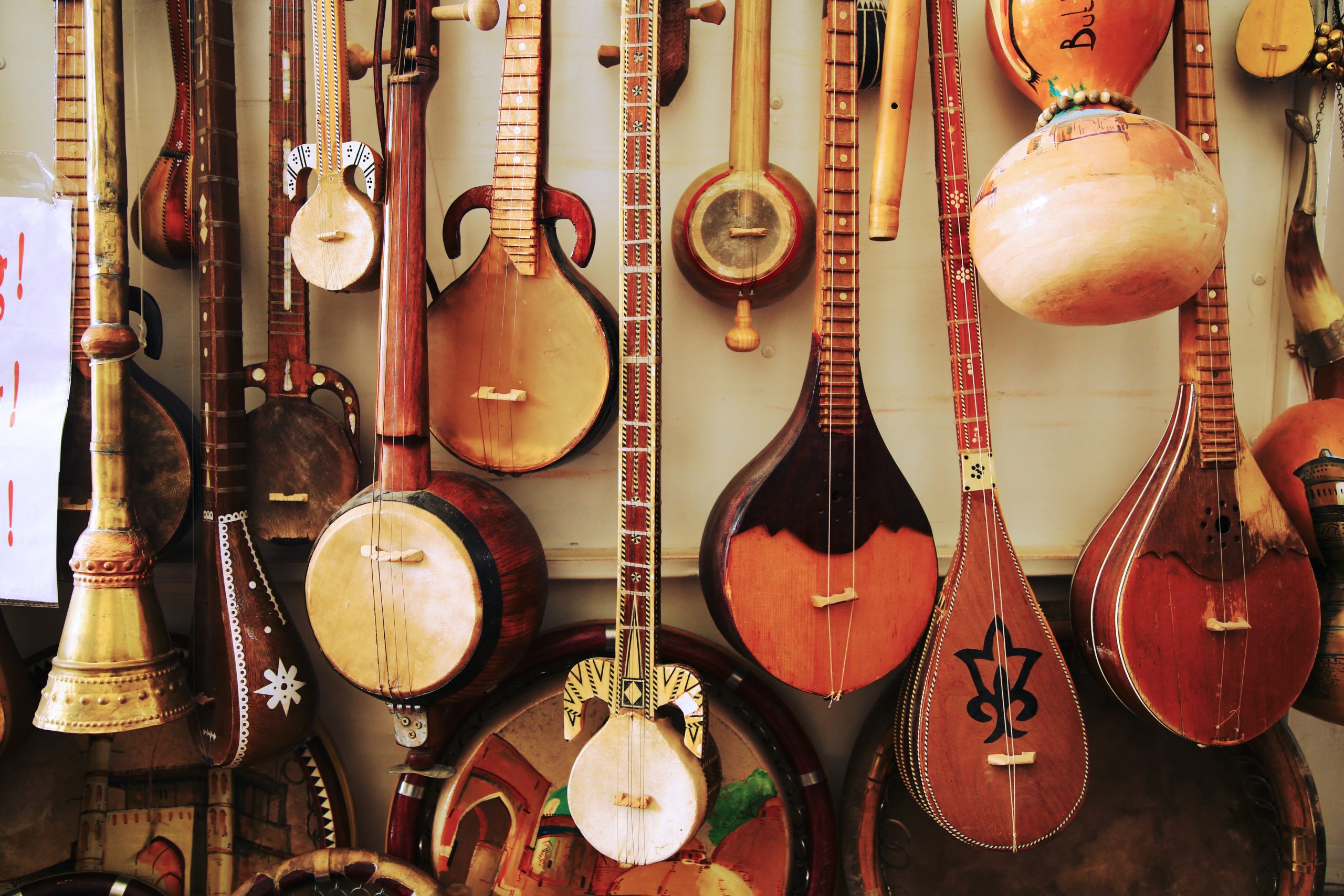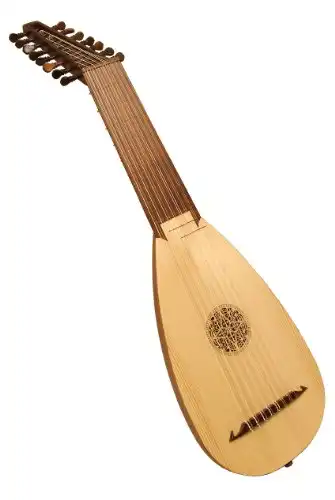Have you ever seen a musician playing the lute on stage and wondered what this instrument is? Or are you simply curious about learning more about this intriguing string instrument? If so, you're in the right place. This ultimate guide will teach you everything there is to know about the lute instrument, from its history and origins to how it's played today. Let's get started.

What Is Lute Instrument?
The lute is a stringed instrument typically made up of a wooden body with a fretted neck. It has a flat back and a rounded front, typically six to eight strings. The strings are plucked with the fingers, and the lute can be played solo or in an ensemble.
It is a guitar family member, including the mandolin, banjo, ukulele, and bouzouki. The lute was very popular during the Renaissance and Baroque periods in Europe and is still played today by musicians worldwide.
The word “lute” comes from the Arabic al-ʿūd (العود), which means “the wood,” referring to the wooden soundboard of the instrument. The lute's ancestors can be traced back to ancient Egypt, where instruments similar to the lute were used in religious ceremonies. By the Middle Ages, the lute had spread throughout Europe and was used by troubadours, minstrels, and other entertainers.
What Is A Lute Instrument Used For?
The lute has a deep, mellow sound that is well-suited for solo playing or accompaniment in ensemble settings. It is often used as an accompanying instrument in songs and instrumental pieces. The lute can be played solo or in an ensemble. When played solo, the lute often takes on the role of the lead instrument, providing the melodic line while other instruments provide accompaniment. The lute's mellow sound can provide a pleasant background texture when played in an ensemble.
The lute is a very versatile instrument. It can be used for various music genres, including classical, jazz, and folk music. It can also be used for special occasions like weddings and parties.
History And Evolution Of The Lute
The lute originated in the Near East during the medieval period and spread to Europe during the Renaissance. It was used extensively in the music of the Renaissance and Baroque eras and continued to be popular in the folk music of the 19th and 20th centuries.
The lute has undergone several changes in its history. It was developed from an Arabic instrument called the oud during the medieval period. The oud had a pear-shaped body and a short neck with no frets. It was played with a quill or plectrum with four or five strings. The lute evolved from the oud during the fifteenth century. It had a long neck with frets and a bowl-shaped body. It was played with the fingers and had six or seven strings.
The lute reached its peak popularity during the Renaissance when it was used by composers such as John Dowland and Giovanni Gabrieli. During the Baroque era, the lute was replaced by the guitar in many European countries. However, it remained popular in Germany, where it was used by Johann Sebastian Bach and George Frideric Handel. The lute began to decline in popularity in the 19th century but experienced a revival in the 20th century thanks to the efforts of lutenists such as Andrés Segovia and Julian Bream.
Construction Of Lutes
Lutes have been constructed in many different ways over the years. The most common way concerning components include:
- Soundboard: Soundboard is the teardrop-shaped flat panel of the lute which usually has a sound hole in the center. The soundboard amplifies the strings' vibrations and transmits them to the air, resulting in the sound we hear. It is typically made of resonant wood like spruce.
- Back: The back of the lute is usually made of a different type of hardwood than the soundboard to create different tonal qualities. The back also has a concave or convex surface, affecting the volume and tone.
- Neck: The neck of the lute is where the strings are attached. It is typically made from a single piece of a light wood with either frets or tied gut strings. The veneer is most commonly used.
- Bridge: The bridge is what the strings are suspended over. It can be made from many different materials but is usually ebony or fruitwood. There is no separate bridge saddle on the lute.
- Frets: Fretting is an important part of playing the lute. The frets are placed at specific intervals on the neck to create different notes when the strings are plucked or strummed. They are made of gut loops and are usually tied around the neck.
- Strings: The strings of the lute are made of the animal gut in combination with metal. They are stretched from the tuning pegs at the top of the neck to the bridge. The number of strings on a lute can vary but is typically between six and twelve. Nylon is also used.
What Is The Example Of A Lute?
The lute family of instruments is one of the oldest and most diverse in all music. Though often associated with early or classical music, lutes have been used in various centuries. The modern ukulele is a direct descendant of the Renaissance-era lute.
Examples of different kinds of lutes include:
- Oud: A Middle Eastern lute with a pear-shaped body and 11 or 12 strings.
- Guitar: A plucked string instrument with a long neck and six strings, typically played with the fingers or a pick.
- Banjo: A four-, five-, or six-stringed instrument with a round body and a long neck, traditionally played with the thumb and two fingers.
- Mandolin: A small, eight-stringed musical instrument with a pear-shaped body, played with a pick or the fingers. Also, a related instrument called the mandola is tuned a fifth below the mandolin.
- Gittern: The small, four- or five-stringed instruments with a pear-shaped body, similar to a mandolin.
- Renaissance Lutes: Renaissance lute is a large instrument with a pear-shaped body, typically between six and 24 strings, played with fingers.
- Theorbo: An extra-long-necked lute with a second pegbox used to extend the range of the instrument.
- Chitarra Battente: An Italian lute with a flat back and wire bass strings, played with a plectrum.
- Baroque Lutes: Baroque lute is a large instrument with a pear-shaped body, typically between six and 24 strings, played with fingers.
- Veena: A South Asian lute with a long, curved neck, typically between 19 and 24 strings, played with fingers.
- Sitar: A plucked string instrument from India with a long neck, typically between 18 and 20 strings, played with fingers.
- Biwa: A Japanese lute with a short neck and four strings played with a pick.
- Shamisen: A Japanese three-stringed lute with a long neck and a rectangular body played with a plectrum.
- Liuqin: A Chinese lute with four strings and a pear-shaped body played with the fingers.
- European Lute: A lute with a pear-shaped body and typically six to eight strings played with the fingers.
- Angolan Lute: A lute with a long neck and typically 10 strings, played with the thumb and two fingers.
The lute is one of the few musical instruments that has remained largely unchanged over the centuries. Though different cultures have developed their versions of the lute, the basic structure and function of the instrument have remained largely consistent.
What Is A Lute Player Called?
The person playing the lute is typically called a lutenist, though this name is not always used. The word “lutenist” comes from the Latin word “lutrina,” meaning “little lute.” The word “lutenist” is also sometimes used, though this term is more often used to describe someone who plays the lute-family instruments, such as the mandolin or guitar.
Luthiers is another word that is used to describe those who play it. With all of these different words, it can be confusing to know what to call a person who plays the lute. In general, the word “lutenist” is used most often.
Is Lute Hard To Play?
Yes, the lute is quite a difficult instrument to play. It is a very old instrument, and few people know how to play it properly. The lute is also very delicate, so it takes a lot of practice to get the hang of playing it without damaging the instrument.
If you are interested in learning how to play the lute, it is important to find a good teacher. There are few lute teachers, so you may have to travel to find one. Once you find a good teacher, they will be able to teach you the proper technique for playing the lute.
Also, make sure to get a good quality lute. There are many types of lutes, and not all are created equal. You want to make sure you get a lute that is made out of good materials, and that is easy to play. Otherwise, you will just be frustrated and end up quitting.
With a good teacher and a good quality lute, you should be able to learn how to play the lute relatively easily. Just remember to be patient, as it will take some time and practice to get the hang of it.
Best Lute Options
Roosebeck 8-Course Travel Lute
FAQs
Is The Violin A Lute?
Yes, it is classified among bowed lutes. Also, there are many other instruments in this group, for instance, the erhu, geigenwerk, and guqin. The invention of the violin is credited to Andrea Amati, with the first models appearing in the 16th century. He was a luthier from Cremona, Italy.
Is The Guitar A Lute?
The guitar is classified as a short-necked plucked lute because it has a solid body and is plucked instead of bowed. Also, it has a shorter neck as compared to other lutes. You can trace the origins of the guitar to ancient Spain.
Is The Lute Easier To Play Than The Guitar?
No, the lute is not easier to play than the guitar. It is difficult to play as it has a complex fingering system. Also, the strings are tuned in irregular intervals not used in modern lute music. This makes it quite hard to find chords on a lute.
What Is The Difference Between A Lute And A Guitar?
The main difference between a lute and a guitar is that a lute is played with the fingers while a guitar is played with picks. Also, a lute has a much shorter neck than a guitar. Additionally, a guitar has frets, while a lute does not.
Conclusion
With its long history, the lute is one of the most popular string instruments. It has a beautiful sound that can be used for various music genres. From classical to contemporary, the lute is a versatile instrument that is enjoyed by musicians all over the world. We hope this guide has helped you learn more about the lute and its many benefits.
EDM Sauce is reader-supported. We may earn a commission through products purchased using links on this page. Learn more about our process here.
Recommended Reading:















